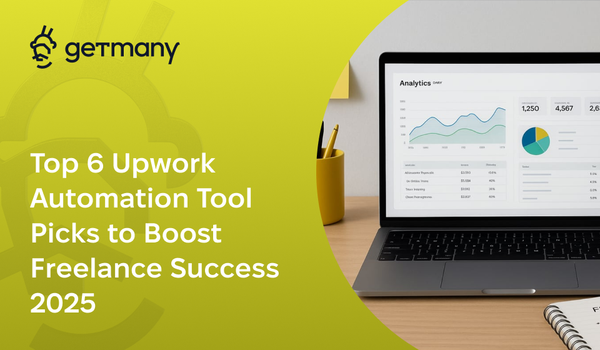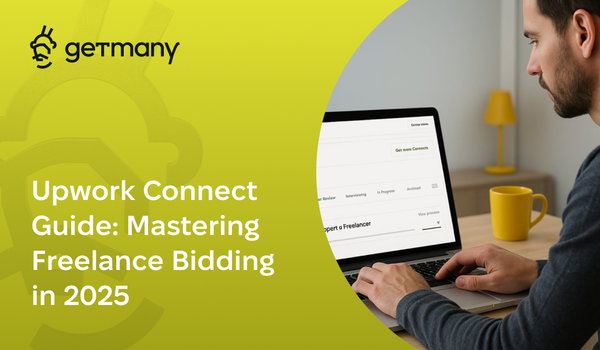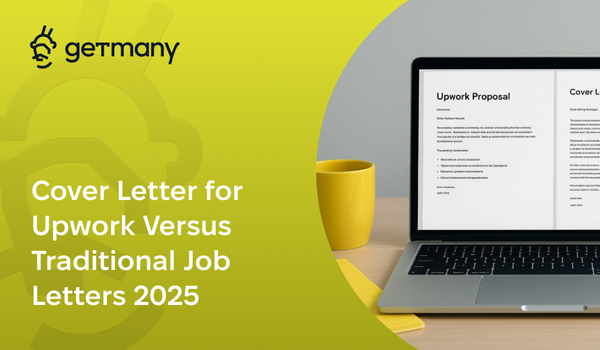Creating a Winning Agency Portfolio on Upwork
Your portfolio converts browsers into buyers - or sends them to competitors. Learn the psychology and strategy behind portfolios that generate 10x more inquiries.
I recently compared two agency portfolios side by side. Both had completed similar projects for similar clients. One generated 3-4 inquiries daily. The other? Radio silence. The difference wasn't in the quality of work - it was in how that work was presented.
Your Upwork portfolio is your silent salesperson, working 24/7 to convert skeptical browsers into eager buyers. Yet 95% of agencies treat their portfolio as an afterthought, uploading random screenshots with minimal context and wondering why premium clients pass them by.
This guide reveals the psychology, strategy, and specific techniques used by top-earning agencies to create portfolios that don't just showcase work - they sell transformation. Whether you're building your first portfolio or optimizing an existing one, these principles will multiply your inquiry rate.
The Psychology of Portfolio Persuasion
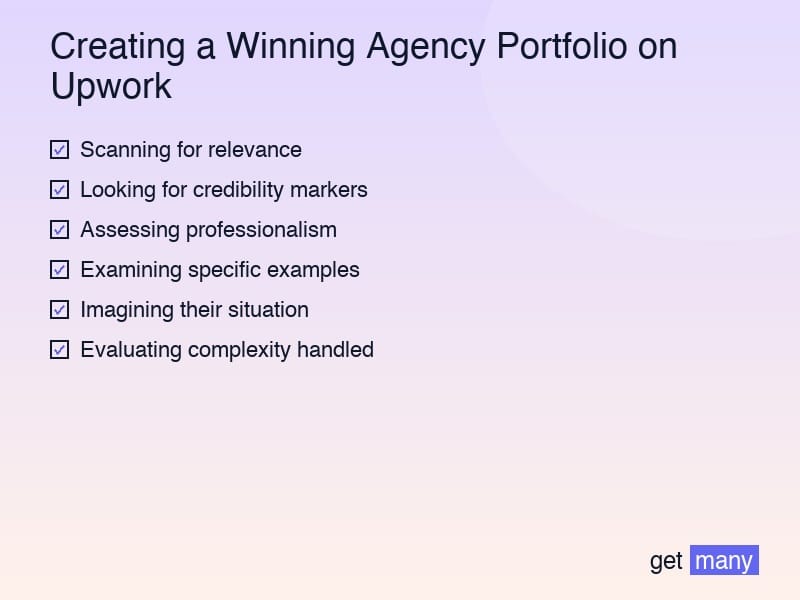
Before adding a single portfolio piece, understand what happens in a client's mind when they browse:
The Client's Mental Journey
Stage 1: Skepticism (0-3 seconds) "Can this agency actually help me?"
- Scanning for relevance
- Looking for credibility markers
- Assessing professionalism
Stage 2: Interest (3-10 seconds) "They might be able to solve my problem..."
- Examining specific examples
- Imagining their situation
- Evaluating complexity handled
Stage 3: Desire (10-30 seconds) "I want these results for my business"
- Reading success metrics
- Feeling emotional connection
- Visualizing transformation
Stage 4: Action (30+ seconds) "I should contact them"
- Looking for next steps
- Checking final credibility
- Making contact decision
Your portfolio must guide them through all four stages.
The Trust Equation Elements
Clients evaluate portfolios through four lenses:
1. Competence: Can you do the work? 2. Relevance: Have you solved my specific problem? 3. Results: Will I get ROI? 4. Professionalism: Are you easy to work with?
Every portfolio piece should address all four elements.
The Anatomy of High-Converting Portfolio Pieces
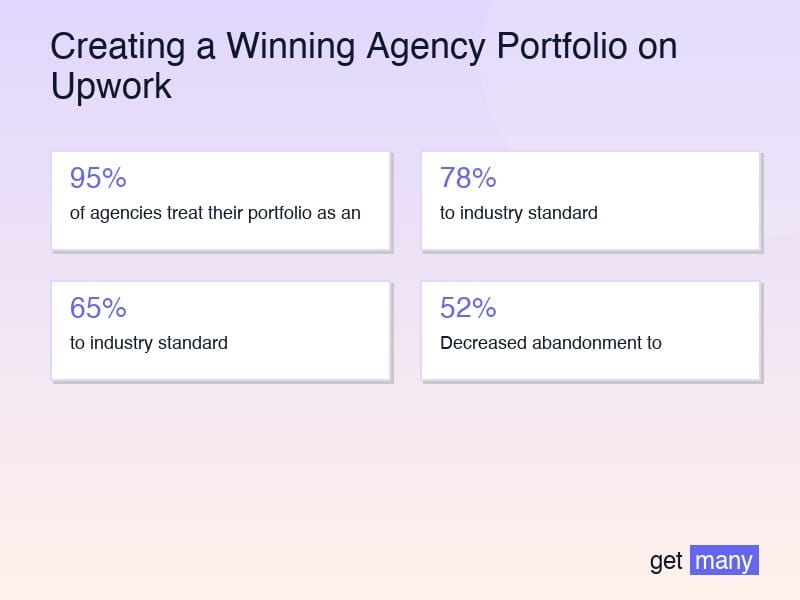
The STAR+R Framework
Structure every portfolio entry using this proven format:
Situation: The client's challenge Task: What needed to be accomplished Action: Your strategic approach Result: Quantifiable outcomes Relevance: Why this matters to viewers
Example Implementation:
Situation: "E-commerce brand losing $50K monthly to cart abandonment" Task: "Reduce abandonment rate from 78% to industry standard 65%" Action: "Implemented 5-stage recovery system with behavioral triggers" Result: "Decreased abandonment to 52%, recovering $73K monthly" Relevance: "Proven system applicable to any e-commerce business"
Visual Hierarchy That Converts
The 3-Layer Visual Strategy:
Layer 1: Hero Image (Immediate Impact)
- Before/after comparison
- Key metric visualization
- Professional screenshot
- Brand recognition
Layer 2: Supporting Visuals (Build Credibility)
- Process diagrams
- Dashboard screenshots
- Technical architecture
- Team collaboration shots
Layer 3: Results Documentation (Seal the Deal)
- Analytics screenshots
- Client testimonials
- Revenue graphs
- Performance metrics
The Power of Transformation Storytelling
Don't just show what you did - show the journey:
Weak: "Built website for tech startup"
Strong: "Transformed outdated startup site into conversion machine"
Compelling: "How we helped TechCo go from 50 visitors/day to 5,000 and increase conversions 312% in 90 days"
Portfolio Piece Types That Attract Premium Clients
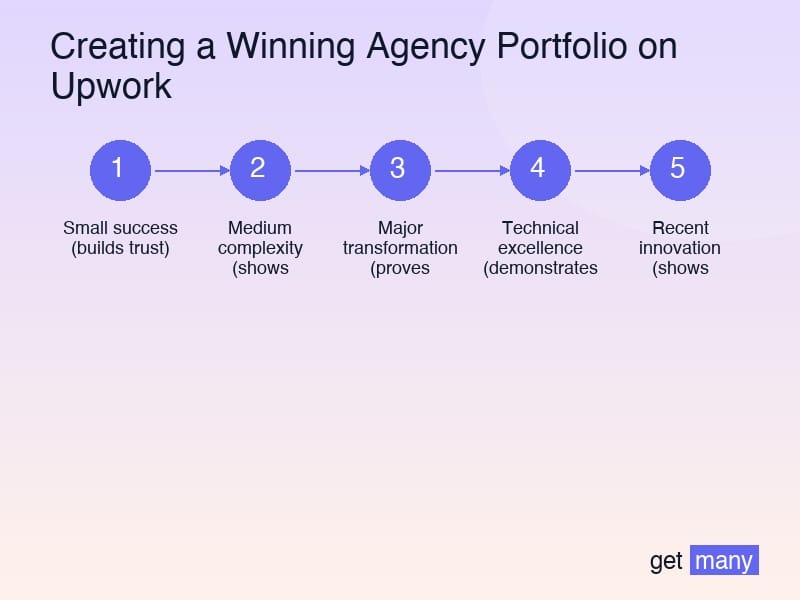
Type 1: The Signature Case Study
Your best, most impressive transformation:
Elements:
- Recognizable client (or similar industry)
- Dramatic before/after
- Multiple success metrics
- Detailed process explanation
- Client testimonial quote
Purpose: Establish immediate credibility and capability
Type 2: The Problem-Solver Series
3-5 pieces showing different problem solutions:
Structure:
- Different industries
- Various challenges
- Consistent excellence
- Increasing complexity
Purpose: Demonstrate versatility and experience breadth
Type 3: The Technical Showcase
Deep dive into technical excellence:
Include:
- Architecture diagrams
- Code quality metrics
- Performance improvements
- Security implementations
Purpose: Attract clients who value technical expertise
Type 4: The ROI Calculator
Projects with clear financial impact:
Metrics to Highlight:
- Revenue increases
- Cost reductions
- Time savings
- Efficiency gains
Purpose: Justify premium rates through proven ROI
Type 5: The Innovation Example
Cutting-edge or creative solutions:
Showcase:
- Unique approaches
- Industry firsts
- Creative problem-solving
- Innovation mindset
Purpose: Position as forward-thinking partner
Advanced Portfolio Optimization Strategies
The Sequential Narrative Method
Arrange portfolio pieces to tell a story:
Sequence Example:
- Small success (builds trust)
- Medium complexity (shows growth)
- Major transformation (proves capability)
- Technical excellence (demonstrates depth)
- Recent innovation (shows currency)
This creates a compelling journey that builds confidence.
The Industry Clustering Technique
Group similar work together:
Benefits:
- Easier for clients to find relevant work
- Demonstrates specialization depth
- Creates expertise perception
- Improves scanning efficiency
Implementation: "E-commerce Portfolio"
- Fashion brand optimization
- Electronics store scaling
- Subscription box platform
The Results Amplification Method
Make outcomes impossible to ignore:
Visual Techniques:
- Large percentage overlays
- Before/after sliders
- Animated growth charts
- Highlighted metrics
Copy Techniques:
- Lead with biggest number
- Use specific figures
- Include timeframes
- Show sustained results
Portfolio Creation for Different Agency Types
Technical Agencies
Focus Areas:
- Architecture decisions
- Performance metrics
- Security implementations
- Scalability achievements
Visual Elements:
- Code snippets (beautifully formatted)
- System diagrams
- Performance graphs
- Technical stack badges
Results Emphasis:
- Load time improvements
- Uptime percentages
- Bug reduction rates
- Feature delivery speed
Creative Agencies
Focus Areas:
- Visual transformation
- Brand evolution
- User engagement
- Aesthetic excellence
Visual Elements:
- High-quality mockups
- Brand guidelines
- Animation examples
- Interactive previews
Results Emphasis:
- Engagement increases
- Brand recognition lifts
- Conversion improvements
- Award recognition
Marketing Agencies
Focus Areas:
- Campaign performance
- Growth metrics
- ROI achievements
- Strategic wins
Visual Elements:
- Dashboard screenshots
- Growth charts
- A/B test results
- Campaign creatives
Results Emphasis:
- Lead generation
- Revenue growth
- CAC reduction
- ROAS improvement
Consulting Agencies
Focus Areas:
- Strategic transformations
- Process improvements
- Organizational change
- Business growth
Visual Elements:
- Strategy frameworks
- Process diagrams
- Implementation roadmaps
- Executive dashboards
Results Emphasis:
- Efficiency gains
- Cost savings
- Revenue growth
- Market expansion
Common Portfolio Mistakes That Kill Conversions
Mistake 1: The Context Vacuum
Problem: Images without explanation Impact: Clients can't understand value Solution: Rich descriptions for every visual
Mistake 2: The Feature Focus
Problem: Showing what you built, not why Impact: No emotional connection Solution: Lead with client outcomes
Mistake 3: The Template Syndrome
Problem: Generic, repetitive presentations Impact: Blend into background Solution: Unique story for each piece
Mistake 4: The Outdated Showcase
Problem: Old work from years ago Impact: Questions current relevance Solution: Refresh quarterly, archive old work
Mistake 5: The Confidentiality Excuse
Problem: "Can't show client work" Impact: No proof of capability Solution: Create anonymized versions
Building Your Portfolio Strategy
The 90-Day Portfolio Transformation Plan
Days 1-30: Audit and Plan
- Analyze current portfolio performance
- Identify top 10 projects to showcase
- Gather missing metrics/testimonials
- Plan visual creation needs
Days 31-60: Create and Optimize
- Design professional visuals
- Write compelling descriptions
- Structure portfolio sequence
- Add supporting elements
Days 61-90: Test and Refine
- Track inquiry changes
- A/B test different approaches
- Gather client feedback
- Optimize based on data
The Portfolio Creation Checklist
For each piece, ensure:
Visual Elements:
- [ ] Professional hero image
- [ ] Supporting screenshots
- [ ] Results visualization
- [ ] Brand representation
Copy Elements:
- [ ] Compelling headline
- [ ] STAR+R structure
- [ ] Specific metrics
- [ ] Client context
Trust Elements:
- [ ] Client testimonial
- [ ] Verifiable results
- [ ] Technical credibility
- [ ] Recent work
Optimization:
- [ ] Mobile responsive
- [ ] Fast loading
- [ ] SEO optimized
- [ ] Easy scanning
Measuring Portfolio Performance
Track these metrics to optimize:
Direct Metrics:
- Portfolio views per week
- Inquiry conversion rate
- Which pieces get most attention
- Client quality from inquiries
Indirect Metrics:
- Profile ranking changes
- Invitation frequency
- Proposal response rates
- Close rate improvements
Testing Framework:
- Change one element at a time
- Test for 2-week periods
- Document all changes
- Measure statistical significance
Your Portfolio Action Plan
Transform your portfolio from mediocre to magnetic:
Week 1: Foundation
- Audit current portfolio
- Identify best projects
- Gather missing data
- Plan improvements
Week 2: Creation
- Design hero images
- Write compelling copy
- Structure sequence
- Add testimonials
Week 3: Implementation
- Upload to Upwork
- Optimize descriptions
- Test different orders
- Monitor performance
Week 4: Optimization
- Analyze metrics
- Refine based on data
- Plan next updates
- Systematize process
The Portfolio Excellence Mindset
Top agencies understand their portfolio isn't just work samples - it's their most powerful sales tool. Every piece should work hard to convert visitors into clients.
Portfolio Success Principles:
- Quality over quantity always
- Results over features
- Stories over specifications
- Transformation over tasks
- Proof over promises
Your immediate action steps:
- Choose your best project and apply the STAR+R framework
- Create one hero visual that shows transformation
- Add specific metrics to every portfolio piece
- Reorder your portfolio using sequential narrative
Remember: clients don't hire agencies with the best skills - they hire agencies that best demonstrate value. Your portfolio is where that demonstration happens.
Ready to create a portfolio that converts? The framework is proven. The impact is immediate. The time is now.
What transformation story will your portfolio tell?



